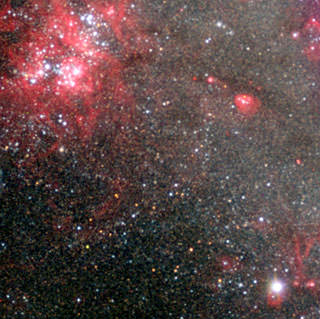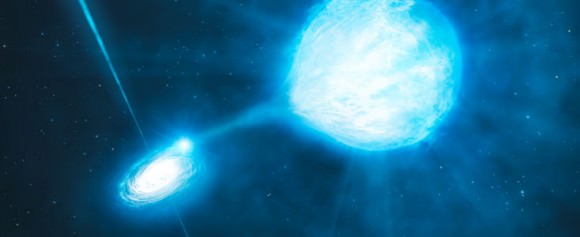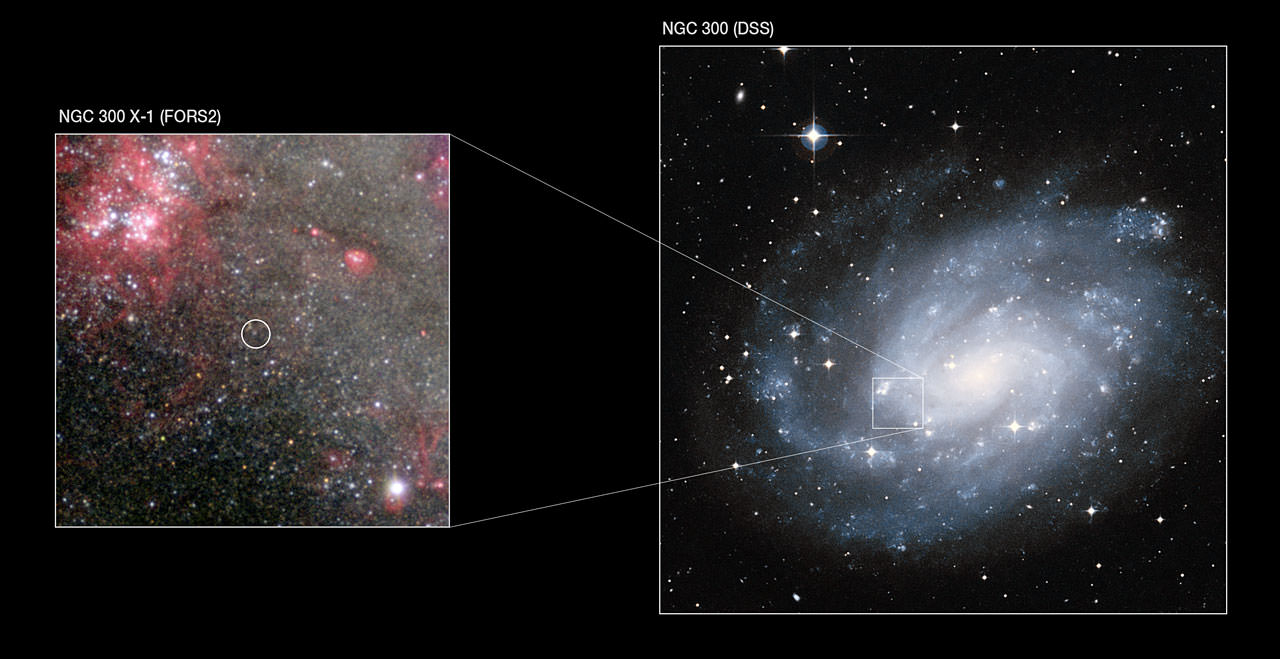[/caption]
Not only is a newly found black huge, it also is the most far-away stellar-mass black hole ever detected. “This is the most distant stellar-mass black hole ever weighed, and it’s the first one we’ve seen outside our own galactic neighborhood, the Local Group,” said Paul Crowther, from the University of Sheffield. Using ESO’s Very Large Telescope, astronomers peered six million light-years from Earth into a spiral galaxy called NGC 300 and found a black hole with a mass above fifteen times that of the Sun. This makes it the second most massive stellar-mass black hole ever found. But soon it could get bigger. The black hole appears to have a nearby partner, a massive Wolf–Rayet star which likely will become a black hole itself, and the two black holes could merge into an even more massive object.

In 2007, an X-ray source in NGC 300 was discovered with the XMM-Newton X-ray observatory and the Swift Observatory. “We recorded periodic, extremely intense X-ray emission, a clue that a black hole might be lurking in the area,” said team member Stefania Carpano from ESA.
Subsequent observations with the VLT’s FORS2 instrument (a visual and near UV FOcal Reducer and low dispersion Spectrograph) confirmed their hunch, but also showed that the black hole and the Wolf–Rayet star circled each other every 32 hours. The astronomers also found that the black hole is stripping matter away from the star as they orbit each other.
“This is indeed a very ‘intimate’ couple,” said collaborator Robin Barnard. “How such a tightly bound system has been formed is still a mystery.”

Stellar-mass black holes are the extremely dense, final remnants of the collapse of very massive stars. These black holes have masses up to around twenty times the mass of the Sun, as opposed to supermassive black holes, found in the center of most galaxies, which can weigh a million to a billion times as much as the Sun. So far, around 20 stellar-mass black holes have been found.
Only one other system of this type has previously been seen, but other systems comprising a black hole and a companion star are not unknown to astronomers. Based on these systems, the astronomers see a connection between black hole mass and galactic chemistry.
“We have noticed that the most massive black holes tend to be found in smaller galaxies that contain less ‘heavy’ chemical elements,” said Crowther. “Bigger galaxies that are richer in heavy elements, such as the Milky Way, only succeed in producing black holes with smaller masses.”
Astronomers believe that a higher concentration of heavy chemical elements influences how a massive star evolves, increasing how much matter it sheds, resulting in a smaller black hole when the remnant finally collapses.
In less than a million years, it will be the Wolf–Rayet star’s turn to go supernova and become a black hole. “If the system survives this second explosion, the two black holes will merge, emitting copious amounts of energy in the form of gravitational waves as they combine,” said Crowther.
But this won’t happen for a few billion years. “Our study does however show that such systems might exist, and those that have already evolved into a binary black hole might be detected by probes of gravitational waves, such as LIGO or Virgo.”
Paper: NGC 300 1-X is a Wolf-Rayet/Black Hole Binary
Source: ESO


It would be interesting if we might observe some of these types of object near the black hole coalescence stage. The lack of gravity wave data from LIGO is disturbing IMO, and frankly the universe does not make much sense without gravity waves. This object in the future will become a black hole binary. Similar objects must also exist, and be in this later stage. The universe need to give us a black hole collision within about 100 mly.
LC
“The lack of gravity wave data from LIGO is disturbing IMO, and frankly the universe does not make much sense without gravity waves.”
I think I’ll wait for the LIGO upgrade before I start to stress too much that it hasn’t seen anything… Donchya think?
I would put it that with upgrades if we don’t get gravity waves I will be more disturbed. I also lost a moderate to sizable bet that gravity waves would be detected by 2010. A universe without gravity waves would be about as nonsensical as one with Coulomb’s law, Gauss’ law, Faraday’s law, but no Maxwellian EM waves.
LC
Black holes just totally fascinate me. But I have a question: How are you actually able to see them and highlight them like this? I thought they were just intense formations of gravity – and therefore invisible?
@ Lisa Roberts,
To answer your question, suppose you have found a region of space where you think that there might be a black hole. How can you check whether there is one or not? The first thing you would like to do is measure how much mass there is in that region. You can determine the mass of an astronomical object by observing its companion’s orbital period and the orbital distance from that object — the tighter and faster the orbit, then the more massive that object will be; e.g., astronomers measure the mass of the Sun by observing how fast the planets orbit it, and we measure the amount of dark matter in galaxies by measuring how fast things orbit at the edge of the galaxy. If you’ve found a large mass concentrated in a small volume, and if the mass is dark, then it’s a good educated guess that there’s a black hole there. There are two kinds of systems in which astronomers have found such compact, massive, dark objects: the centers of galaxies (including our own Milky Way Galaxy!), and X-ray-emitting binary systems in our own Galaxy.
In the latter case, these objects may be detected by X-ray telescopes in space observing “accretion discs” around the suspected black hole. Due to conservation of angular momentum, gas falling into the gravitational well created by a massive object will typically form a disc-like structure around the object. Friction within the disc causes angular momentum to be transported outward allowing matter to fall further inward releasing potential energy and increasing the temperature of the gas. In the case of compact objects such as white dwarfs, neutron stars, and black holes, the gas in the inner regions becomes so hot that it will emit vast amounts of radiation — mainly X-rays.
So, suppose you’ve found an X-ray binary system, how the hell can you tell whether the unseen compact object is a black hole? Well, one thing you would certainly like to do is to estimate its mass. By measuring the orbital speed of the visible star (together with a few other things like, er… some serious math!), you can figure out the mass of the invisible companion object — the faster the visible star is orbiting, the stronger the gravitational force is required to keep it in place, and so the more massive that invisible companion object will be. If the mass of the compact object is found to be extremely large, then there is no kind of object known to astrophysics that it could be other than a black hole — an ordinary star of that mass would be visible; whereas a stellar remnant such as a neutron star would be unable to support itself against gravity, and would collapse to a black hole. The combination of such mass estimates and detailed studies of the radiation from the accretion disk can supply powerful circumstantial evidence that the object in question is indeed a black hole.
😎
ADDENDUM: I should also mention the fact that where two stellar objects of a binary system are of similar masses, as those mentioned in the above article, they orbit each other around a common center of gravity.
Great explanation – thank you very much 🙂
It totally blows my mind when I start thinking about space and the universe. And I find black holes especially interesting.
This is such an interesting website! I’ve been browsing around here for hours since I found it!
Don’t want to sound crazy here (LOL) … But does anyone actually know where black holes lead yet? Last time I checked there were tons of different theories. But perhaps the most prominent were;
a) Nowhere. Once you hit the ‘end’ of a black hole, you are reduced to nothing by the shire force of the gravity.
b) To a parallel universe… Whatever the hell that means.
Any thoughts?